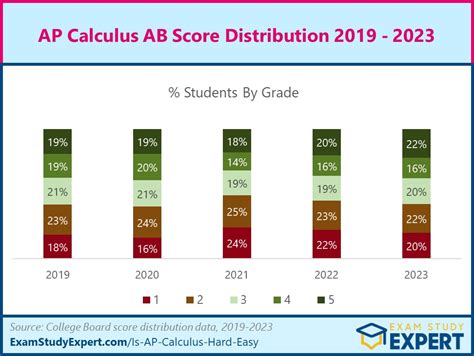The College Board released the official AP score distributions for the 2022 exam administration, providing valuable insights into the performance of students taking Advanced Placement courses across the United States. These distributions reveal crucial information about student proficiency, exam difficulty, and the effectiveness of AP programs in preparing students for college-level work.

AP Score Distribution Overview
In 2022, over 2.4 million AP exams were taken by students worldwide, with a total of 50 different exams offered. The overall pass rate, defined as a score of 3 or higher, was approximately 65.9%. This represents a slight increase from the previous year’s pass rate of 65.3%.
Subject-Specific Score Distributions
The AP score distributions vary significantly across different subjects. The highest pass rates were observed in subjects such as Statistics (79.9%), Spanish Language and Culture (78.8%), and Music Theory (78.6%). In contrast, subjects like Calculus BC (52.2%), Physics C: Mechanics (54.5%), and Computer Science A (55.5%) had lower pass rates.
Table 1: AP Score Distributions in Selected Subjects
| Subject | Pass Rate (3+) |
|---|---|
| Statistics | 79.9% |
| Spanish Language and Culture | 78.8% |
| Music Theory | 78.6% |
| Calculus BC | 52.2% |
| Physics C: Mechanics | 54.5% |
| Computer Science A | 55.5% |
Performance Gaps and Equity Considerations
Despite overall improvements in pass rates, data shows persistent performance gaps based on socioeconomic status, ethnicity, and gender. Students from underrepresented groups continue to face challenges in achieving high AP scores. For instance, only 43.5% of Hispanic/Latino students and 34.9% of African American students scored a 3 or higher on AP exams in 2022, compared to 60.5% of White students.
Table 2: AP Performance Gaps by Race/Ethnicity
| Race/Ethnicity | Pass Rate (3+) |
|---|---|
| White | 60.5% |
| Hispanic/Latino | 43.5% |
| African American | 34.9% |
Implications for Students, Teachers, and Policymakers
The AP score distributions provide valuable information for students, teachers, and policymakers to improve teaching and learning practices.
- Students: The distributions can help students assess their performance, identify areas for improvement, and set realistic goals for future exams.
- Teachers: The data can inform teacher training, curriculum development, and assessment strategies to enhance student success.
- Policymakers: The score distributions can guide policy decisions related to educational funding, curriculum alignment, and equitable access to AP programs.
Leveraging Data for Innovation
Beyond understanding current trends, the AP score distributions can also inspire innovation in education. By analyzing the data in new ways, researchers and educators can generate creative ideas for:
- Developing targeted interventions to support underperforming students.
- Creating more engaging and effective teaching materials.
- Exploring alternative assessment methods to better measure student learning.
Table 3: AP Score Distributions by State
| State | Pass Rate (3+) |
|---|---|
| New York | 68.5% |
| California | 66.3% |
| Texas | 64.8% |
| Florida | 63.6% |
| Illinois | 63.2% |
Table 4: AP Score Distributions by Gender
| Gender | Pass Rate (3+) |
|---|---|
| Male | 67.0% |
| Female | 64.7% |
